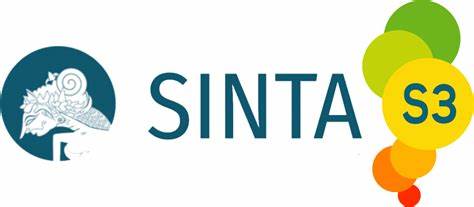INDONESIAN UNDERGRADUATE STUDENTS’ PERCEPTIONS OF PLAGIARISM: A SURVEY STUDY
DOI:
https://doi.org/10.22460/eltin.v11i1.p47-56Keywords:
academic reading and writing, perceptions, plagiarismAbstract
This study aimed to identify Indonesian undergraduate students' perceptions of plagiarism in an English language education department at a private university in Indonesia. This method in this study is a survey study and the instrument in this study used a questionnaire, which means is quantitative research. The data were collected using a 22-item questionnaire on plagiarism awareness adapted from Jereb et al. (2018). One hundred three students taking Academic Reading and Writing classes participated in this study. The students who filled out the questionnaire on Google Forms used 5 – a point Likert scale to respond to the statement. It can be seen the results of the data from five aspects. The highest score belongs to the awareness of plagiarism (M= 4.2; SD= 1.138). The second-highest score belongs to the aspects of plagiarism knowledge (M= 3.12; SD= 1.118). The third-highest score is the attitude towards plagiarism (M= 2.45; SD= 1.012). The fourth-highest score belongs to the aspects of acceptability of plagiarism (M= 2.38; SD= 1.032). Then, the lowest mean score belongs to the unknowingness of plagiarism (M= 2.18; SD= 1.092). The findings showed that most students are aware of plagiarism, although plagiarism is wrong. Plagiarism occurs due to several demands from teachers or institutions; another plagiarism factor is a lack of knowledge about plagiarism.
References
Ashworth, P., Bannister, P., Thorne, P., & Students on the Qualitative Research Methods Course Unit. (1997). Guilty in whose eyes? University students' perceptions of cheating and plagiarism in academic work and assessment. Studies in higher education, 22(2), 187-203. https://doi.org/10.1080/0307507971233138103
Ashworth, P., Freewood, M., & Macdonald, R. (2003). The Students' Life World And The Meanings of Plagiarism. Journal of Phenomenological Psychology, 34(2), 257 – 78.
Ashworth, P., Bannister, P., Thorne, P., & Students on the Qualitative Research Methods Course Unit. (1997). Guilty in whose eyes? University students' perceptions of cheating and plagiarism in academic work and assessment. Studies in higher education, 22(2), 187-203.https://doi.org/10.1080/0307507971233138103
Babalola, Y. T. (2012). Awareness and incidence of plagiarism among undergraduates in a Nigerian private university. African Journal of Library, Archives and Information Science, 22(1), 53-60.
Borg, E. (2000). Citation practices in academic writing. Patterns and perspectives: Insights into EAP writing practice, 26-42.
Cooper, H. (2016). Principles of Good Writing: Avoiding Plagiarism. American Psychological Association.
Ehrich, J., Howard, S. J., Mu, C., & Bokosmaty, S. (2016). A comparison of Chinese and Australian university students’ attitudes towards plagiarism. Studies in Higher Education, 41(2), 231–246. https://doi.org/10.1080/03075079.2014.927850
Fatimah, F., & Wulandari, I. (2018). Perception of plagiarism among students of higher education in Indonesia. Alphabet: A Biannual Academic Journal on Language, Literary, and Cultural Studies, 1(1), 30-40.
Fishman T. (2009). We Know it When We See it is not Good Enough: Toward a Standard Definition of Plagiarism racism that Transcends Theft, Fraud, and Copyright. Paper presented at the 4th Asia Pacific Conference on Educational Integrity, NSW, Australia. Available from: http://www.bmartin.cc/pubs/09-4apcei/4apcei-Fishman.pdf
Flint, A., Clegg, S., & Macdonald, R. (2006). Exploring Staff Perceptions of Student Plagiarism. Journal of further and higher education, 30(02), 145-156.
Gunawan, H. (2014). Dosen Lebih Suka Menjiplak, Tahun Lalu Ada 808 Kasus Plagiarism. Tribunnews.
Hu, G., & Lei, J. (2015). Chinese University Students’ Perceptions of Plagiarism. Ethics & Behavior, 25(3), 233-255. http://www.tandfonline.com/10.1080/10508422.2014.923313
Hussein, M, G. (2022). The awareness of plagiarism among postgraduate students at Taif University and its relationship to certain variables. Cogent Social Sciences. 8(1), p, 1-19. https://doi.org/10.1080/23311886.2022.2142357
Jereb, E., Urh, M., Jerebic, J. & Sprajc, P. (2017). Gender Differences and The Awareness of Plagiarism in Higher Education. Soc Psychol Edu. https://doi.org/10.1007/s11218-017-9421-y
Jereb, E., Perc, M., Lammlein, B., Jerebic, J., Urh, M., Podbregar, I., & Sprajc, P. (2018). Factors Influencing Plagiarism in Higher Education: A Comparison of German and Slovene Students. Slovenian Research Agency. https://doi.org/ 10.1371/journal.pone.0202252
Jones, K. O., Reid, J. M., & Bartlett, R. (2005). Student plagiarism and cheating in an IT age. In Proceedings of the International Conference on Computer Systems and Technology, pages IV (Vol. 8, pp. 1-6).
McCabe, D. L., Treviño, L. K., & Butterfield, K. D. (2001). Cheating in academic institutions: A decade of research. Ethics &Behavior, 11(3), 219-232.
Newstead, S. E., Franklyn-Stokes, A., & Armstead, P. (1996). Individual differences in student cheating. Journal of Educational Psychology, 88(2), 229. https://doi.org/101.1037/0022-0663.88.2.229
Panjaitan, H. (2017). Sanksi Pidana Plagiarisme Dalam Hukum Positif di Indonesia. Jurnal Hukum to-ra, 3(2), 551-556.
Pecorari, D., & Petrić, B. (2014). Plagiarism in second-language writing. Language
Teaching, 47(3), 269-302.
Prihantini, F. N & Indudewi, D. (2016). Kesadaran dan Perilaku Plagiarisme dikalangan
Mahasiswa (Studi pada Mahasiswa Fakultas Ekonomi Jurusan Akutansi Universitas
Semarng). Jurnal Dinamika Sosial Budaya, 18(1), p. 68-74.
Rodhiya, N., Wijayati, P. H., & Bukhori, H. A. (2020). Graduate students attitude toward plagiarism in academic writing. International Seminar on Language, Education, and Culture KnE Social Science, 206–212. https://doi.org/10.18502/kss.v4i4.6484
Sureda-Negre, J., Comas-Forgas, R., & Oliver-Trobat, M. F. (2015). Academic plagiarism among secondary and high school students: Differences in gender and procrastination. Comunicar: Revista CientÃfica de ComunicacÃon y EducacÃon, 22(44), 103-111.
Ursachi, G., Horodnic, I, A., & Zait, A. (2015). How reliable are measurement scales? External factors with indirect influence on reliability estimators. Procedia Economic and Finance, 20, p. 679 – 686.
Wilkinson, J. (2009) Staff and Student Perceptions of Plagiarism and Cheating. International Journal of Teaching and Learning in Higher Education, 20(2), p. 98-105. http://www/isetl.org/ijtlhe/
Yi, N., Nemery, B., & Dierickx, K. (2020). Perceptions of plagiarism by biomedical researchers: an online survey in Europe and China. BMC Medical Ethics, 21(1), 1-16.





